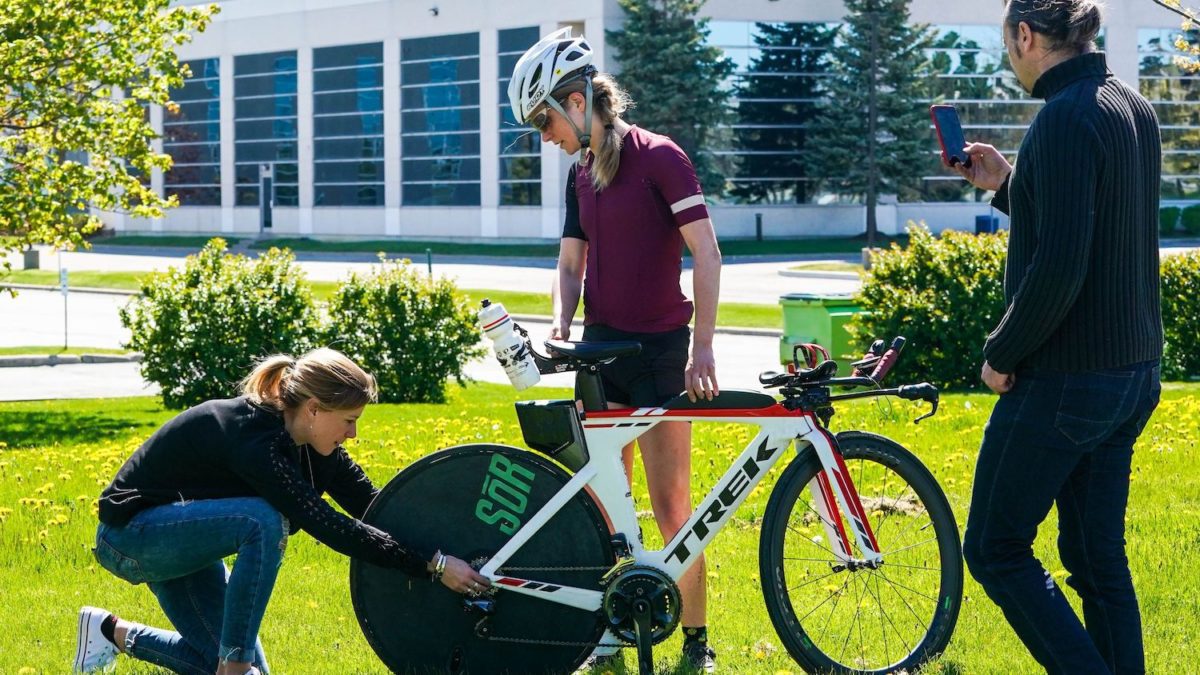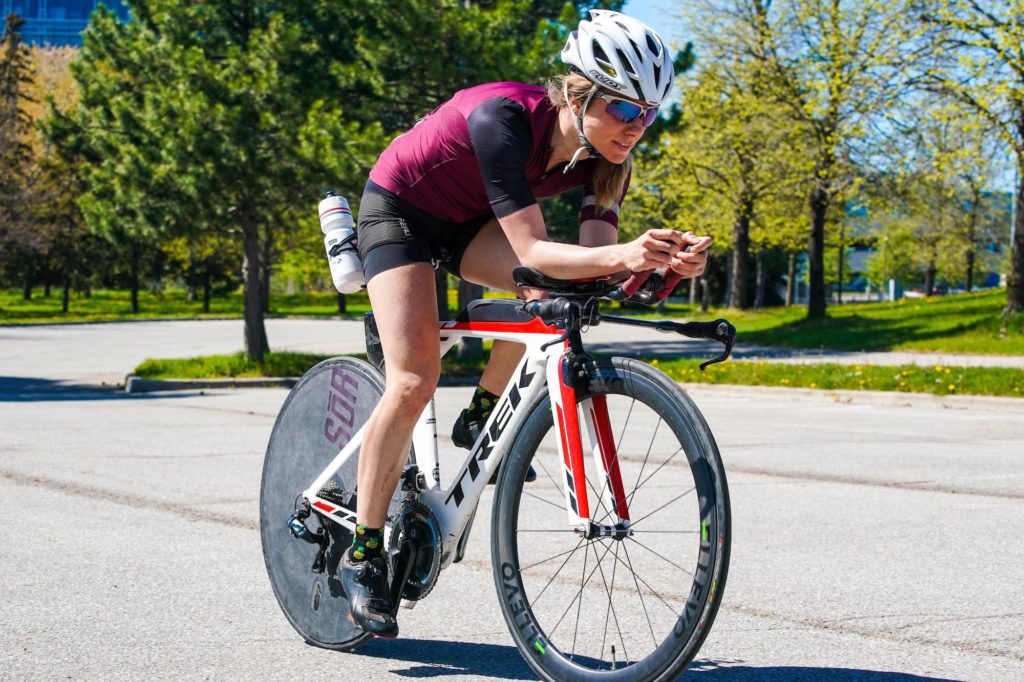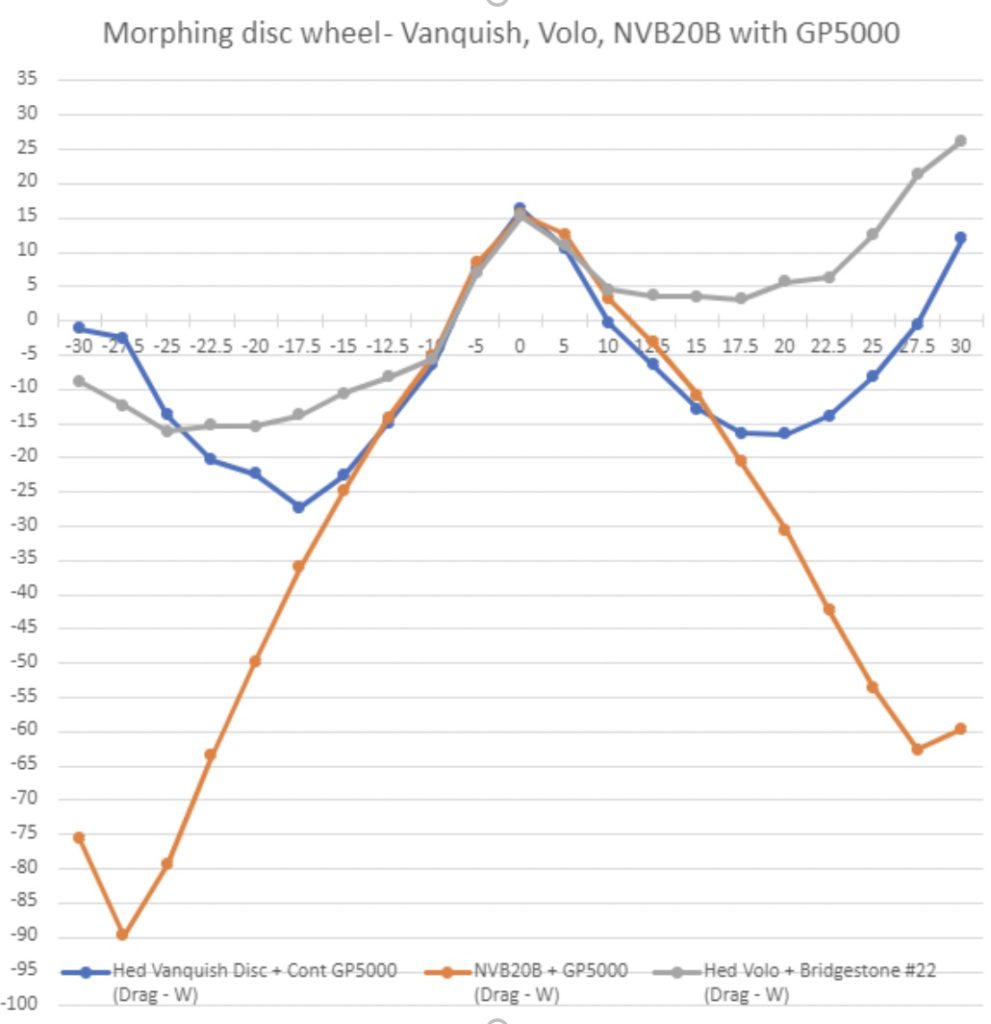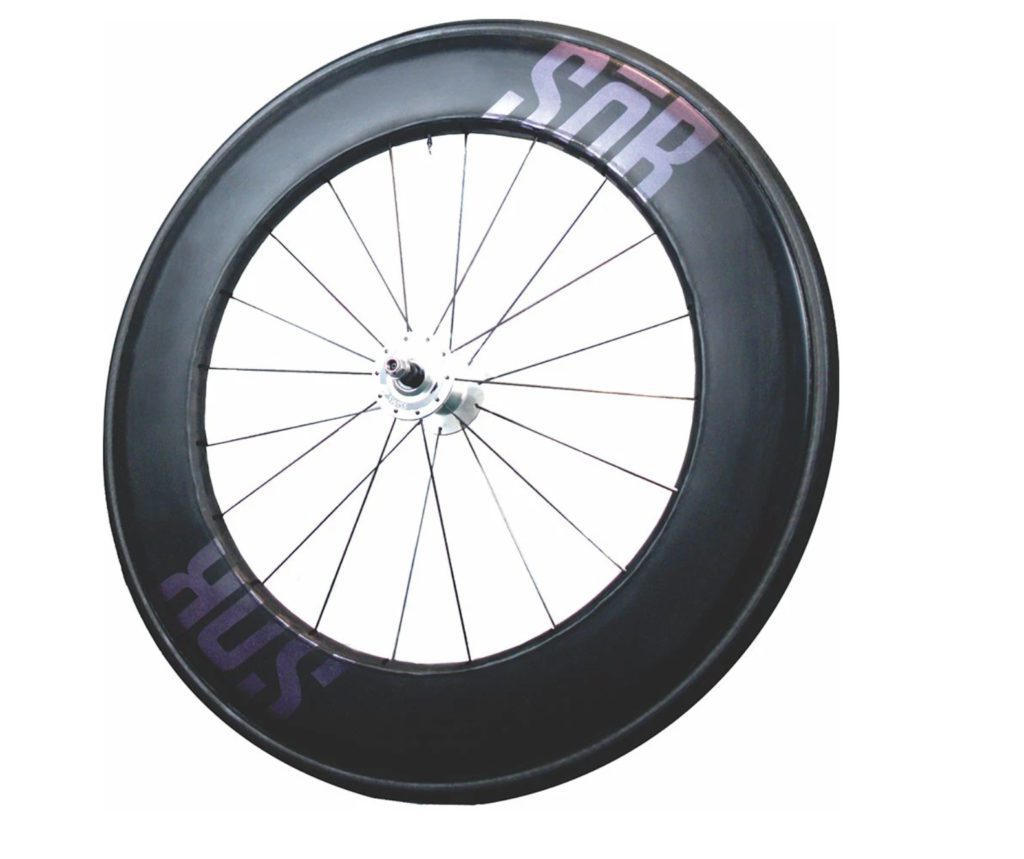Cervelo founder Phil White and former pro Nicole van Beurden harness the power of wind with revolutionary new wheels
Sōr Cycles looks to revolutionize the wheel industry
 Photo by:
Kevin Mackinnon
Photo by:
Kevin Mackinnon
How did a young female inventor and former pro triathlete with a DYI aesthetic and a completely untraditional approach to design become the business partner of one of Canada’s most successful masterminds of aerodynamics? Nicole van Beurden’s radical wheel prototypes were outlandish enough to get the attention of Phil White, the co-founder of Cervélo bikes and president of 4iiii Innovations, because he immediately perceived the complexity of thought that produced them—precisely the kind of thinking he finds refreshing and challenging. “Nicole is brilliant. She’s something of a unicorn. I love working with people who think totally outside of the box,” White explains of his business partner.
Together they are an innovation dream team. “She had a counterculture way of looking at headwinds and I had a very traditional way of looking at internal work. Nic’s concept was completely new and together we’ve been able to put it context, measure it, and figure out how to actually build it,” says White. But the collaboration caught them both off guard. White, who regularly is pitched “the next great thing in bikes,” agreed to have a look when asked to check out Van Beurden’s concept, but admits expecting to be underwhelmed. For her part, van Beurden was bracing herself for yet another dismissive response about women in tech, let alone self-taught women in tech. With no formal engineering background, Toronto-based van Beurden, has been a student of the bike industry since the former varsity basketball player got her first bike the summer before university. She quickly found triathlon and was hooked, but not just athletically—she became fascinated by the bike itself. She’s as eclectic in her work as she is in her thinking. A kinesiologist and endurance sport coach, van Beurden is also highly sought after for her carbon repairs and stunning paint jobs. The generally understated van Beurden doesn’t advertise her carbon and paint work widely because she would not be able to keep up with demand. Her orders are time consuming, but the results are flawless. Like White, she is a perfectionist when it comes to her craft. She spent almost 10 years tinkering with the prototypes for a disc wheel before entering into a collaboration with White, often building her prototypes until 4:00 am following a full day of contracts.

Since they joined forces in 2018, van Beurden and White have refined and perfected a disc wheel that stands to revolutionize the cycling world. Their company, Sōr Cycles, is as much think-tank as it is product manufacturing, with the aim of pushing the boundaries of functionality and refining the aesthetics of design in the industry. “This isn’t a huge business opportunity,” insists White, “we don’t intend to get rich on it. We see it as an opportunity to try really new things and take the industry in a different direction that makes more sense for athletes.” van Beurden’s own experience as a professional long course triathlete was central to her quest for rideable speed. The advantages of a disc wheel are, of course, only achievable if the rider can handle the potential instability. Triathletes who have raced in Kona or Lanzarote, for example, will know just how hard it can be to handle an aero bike, let alone an aero bike with a disc wheel, in windy conditions.
The ethos of the Sōr is accessibility, ensuring that a wider range of riders can capitalize on the speed advantages offered by their products. “This wheel solves the problems that have been overlooked in the past and we want all riders, even smaller, lighter riders to be able to enjoy the benefit of these innovations. While we believe in our own wheel, we think all wheel manufacturers should follow suit,” says van Beurden. The company has patented the design in Europe, China, and North America. Importantly, this stands to impact many female riders who are often lighter than the intended rider for all other disc wheels on the market, making a powerful contribution towards gender equity in the sport. The potential to contribute to the adaptive equipment of para athletes is also something Sōr hopes to do more of. The pair volunteered with the national team in advance of the UCI Para-cycling Track World Championships that were held in Milton, Ont. in 2020, creating custom adaptations to equipment, and dialing in rider position.
While van Beurden is more obviously the practicing artist among the two, White also has a deep commitment to the creative process: “I just I love design. I love both the aesthetic and functional portion of it. It’s great to make something that is just totally functionally-oriented and beautiful at the same time.” Even though Gerard Vroomen and White sold Cervélo in 2012, White has been extremely active in the industry and beyond. The curiosity and open-mindedness that led him to partner with van Beurden speak to a humility and commitment to progress he shares with her. They are more alike than a first glance might suggest.
White definitely doesn’t seem content to simply rest on his laurels, even though they would certainly merit doing so. Intellectually curious and quietly confident, they both work damn hard and in multiple capacities. White is the current acting president of the electronics and sensor technology company 4iiii, while consulting widely in the industry and launching Sōr with van Beurden. Neither one is the least bit afraid of doing the unexpected.

Since their partnership began, it’s been a constant process of tweaking by implementing both rider feedback (they have a number of pros riding the wheels) and results from wind tunnel testing in San Diego. In March of 2021 they yielded the most impressive results yet. At 28 degrees yaw, the Sōr wheel produces 90 watts of thrust, or 90 watts of free power. Other disc wheels typically stall between 8 and 12 degrees. When a wheel stalls, air detaches and becomes turbulent – aerodynamic benefits are reduced, and instability occurs. Only HED has a few standout disc wheels that don’t stall until 15 to 18 degrees.
As depicted in the drag chart below from the latest wind tunnel results, the Sōr wheel (orange line) yields huge amounts of negative drag (thrust). The greater the yaw angle, the greater the thrust. It also remains completely stable in crosswinds. The sidewall morphs to absorb the wind so that the internal structure and rim remain unaffected. Current disc wheels that produce negative drag do so at the point where they are most unstable. A disc wheel in a hard crosswind can blow a rider off the road – not only posing a safety risk, but necessarily forcing a shift in rider focus out of race mode and into survival mode. In those circumstances, riders must spend energy and focus on restabilising rather than moving forward. This is one reason why so few racers buy disc wheels – many are unable to cash in on the claimed aerodynamic advantages they offer. In the case of the Sōr wheel, however, regardless of the rider’s weight and ability, the wheel self-stabilizes so the rider doesn’t have to.
Age group triathlete Paula van Nostrand was among the first people to test the wheel at various stages of development, racing on it for the first time at the Toronto Triathlon Festival in 2013. “There’s only one steady climb on that course,” she explains, “and I actually felt like somebody was pushing me up the hill. It was surreal.”
As a bike versus run specialist, Van Nostrand is particularly thrilled by what she calls the secondary benefit of the wheel, a substantial energy preservation particularly noticeable over the Ironman distance. “You’re not using nearly as much energy, so I definitely feel like it saves my legs for the run.” Van Nostrand became absolutely sold on the Sōr wheel on a gusty day at Ironman Florida in 2013. With no other option than the Sōr prototype, Van Nostrand had to politely thank her fellow racers and volunteers who warned her against riding a disc wheel in such conditions. Not only did she feel safe and stable, but she went blazing fast, clocking a 5:04. “I was among the fastest non pro female cyclists in that race,” she adds. “It was it was wonderful.”
Masters triathlete-turned road cyclist, Eileen McMahon, agrees. She also tested an early Sōr prototype for a season, noting, “I would never have bought a disc wheel given my concerns of not being able to handle it, but I could. It was so much easier for me to keep up with the (mostly guys) I ride with!”
What makes this wheel so different?
In short, it’s the first time the interplay of aerodynamics, weight and stability doesn’t result in a sacrifice of one over the other. Traditionally, the more aerodynamic a wheel, the less stable it is in winds (particularly cross winds) and the heavier it is. Before Sōr, no one seemed to question why you can’t have all three.
With a company tag line of “Ride the Wind,” it is clear the design is not just about making equipment as invisible to the wind as possible, but actually harnessing the wind itself. “You can’t change the rider, but you can change the equipment to work more effectively with the environment and the rider,” explains van Beurden, “This wheel works with the wind.”
The design is both conceptually complex, requiring van Beurden and White to think outside accepted practice and research in the cycling world, and yet simple enough for van Beurden to hand build in her living room each of the 23 prototypes that have made it to the wind tunnel. Only after she began trying to understand what she was feeling while riding her prototypes did van Beurden realize a precedent in the sailing industry, specifically, in the America’s Cup boats. With only a rudder Foil and T Foil in the water at a given moment, most of the surface area of the boats actually sits not in the water, but in the wind, allowing the boats to sail at three times the wind speed and to literally ride the wind.
Related: 2021 Buyer’s Guide – Tri-friendly bike wheels
How does this translate to the wheel itself?
There are three distinct differences in the design that set it apart from anything else on the market.
The first is a morphing sidewall which allows it to absorb gusts. The surface area of the wheel is actually flexible. Not only is this crucial for stability, but the secondary effects of that are huge including being able to stay mentally focused while riding without worrying about being blown around. “It actually creates lift by flexing,” explains White. The wheel forms the most aero shape for the any wind condition. “It absorbs itself and passively adapts to what’s actually happening out there—like a bird’s wing. No one else does that,” White continues.
The second difference is that it harnesses the wind by turning crosswinds into forward thrust. This results in ideal stability and zero stalling. The stalling is what creates turbulent airflow which in turn creates drag. Without that, the Sōr wheel has an unparalleled aerodynamic advantage.
The third distinction is that it’s astonishingly light. Given its internal structure and morphing skin, it does not contend with the limiting tradeoff between aerodynamics and weight. The current model is about 400 grams lighter than the lightest disc wheels on the market, but there is room to go even lighter the pair insists.
How can it possibly be so light?
As van Beudern explains, “The traditional aerodynamic disc wheel is more like an exoskeleton. Whereas the morphable sidewall of the Sōr wheel is enabled internally so it’s like an internal skeleton.” The rigid outside of the traditional disc wheel requires a rigid core (typically a honeycombed foam or carbon). The structural integrity of the Sōr wheel comes from inside, which means it can be as light and strong as possible without needing to be aerodynamic. “So you have a wheel that is as light as can possibly be that is as stable as you could hope to ever get. And any rider can ride it on any course, on any day, in any weather condition,” she insists.
The van Beurden-White collaboration has been a process of discovery. “When we first went to the wind tunnel it was like, holy crap, this thing really does work! Actually seeing it in the wind tunnel, and just how much it morphed and adapted to the wind without stalling was incredible,” White recounts excitedly.
In addition to the disc wheel, Sōr also has front race wheels at various depths based on the same design, which means they are also more stable and lighter than other race wheels. The disc wheels are available for pre-orders directly through the company [sorcycles.com]. Covid-related manufacturing shortages worldwide are likely to impact orders through the summer.
Even in a pandemic, however, Sōr is not stalling. It’s adapting and riding the wind into a whole new dimension of performance cycling.
Toronto’s Suzanne Zelazo is a former pro triathlete and coach.


